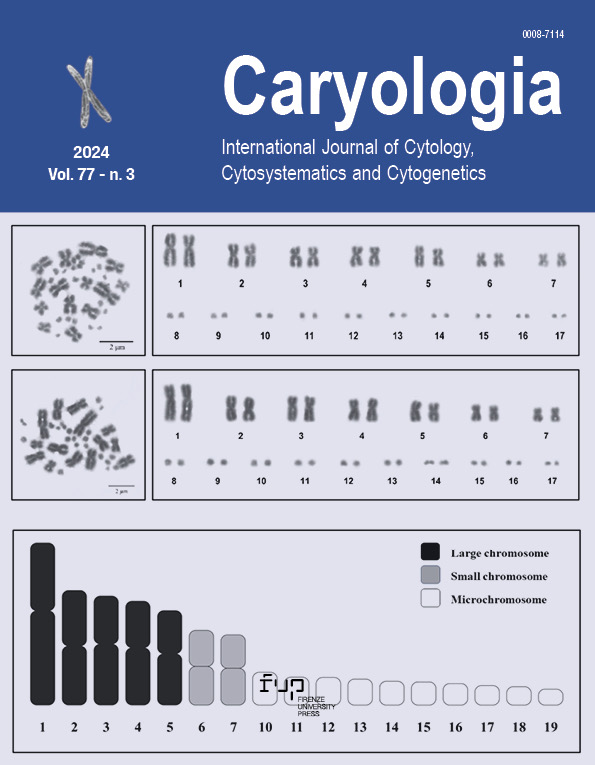Karyomorphology and microsatellites characterization of Limnonectes gyldenstolpei: first report from Thailand
DOI:
https://doi.org/10.36253/caryologia-2868Keywords:
Limnonectes gyldenstolpei, Karyotype, chromosome, microsatellitesAbstract
In the present investigation, karyotype and microsatellites pattern in the chromosome of Gyldenstolpe’s Frog (Limnonectes gyldenstolpei) have been analyzed. The aspect of chromosome numbers, morphology, nucleolus organizer region (NOR) locations and microsatellites pattern [d(CA)15, d(CGG)10, d(GC)15, d(TA)15]. We provided the karyotype and idiogram of this species by conventional staining, Ag-NOR banding and Fluorescence in situ hybridization techniques. For the study, five male and female samples collected from northern Thailand, were used. The metaphase chromosome preparations were prepared from the bone marrows by the standard protocol. The result shows that L. gyldenstolpei had the diploid chromosome number (2n) was 26 and the fundamental number (NF) were 56 in both males and females. The karyotype is composed of 4 large metacentric, 4 large submetacentric, 2 medium metacentric, 14 small metacentric and 2 small submetacentric chromosomes. The NORs bearing chromosome were in close to the telomere region on chromosome pair 1. In addition, the microsatellite d(CGG)10 and (GC)15 hybridization results confirmed the NOR region. The in situ localization pattern of d(CA)15 microsatellites was positive on all telomere chromosome, while microsatellites d(TA)15 have no signal on chromosome. Here we provide a classical and some molecular genetics information for L. gyldenstolpei useful as a species specific marker.
Downloads
References
Donsakul T, Rangsiruji A. 2005. Liver karyotypes in Limnonectes blythii, Rana erythraea, Rana leptoglossa, Occidozyga martensii and Glyphoglossus molossus (Amphibia, Anura). Proceedings of 43rd Kasetsart University Annual Conference, Thammasart University, Bangkok.
Frost DR. 2016. Amphibian Species of the World:an on-line reference. Version 6.0. American Museum of Natural History, New York, USA.
Gorman GC. 1973. The chromosomes of the Reptilia, a cytotaxonomic interpretation. Cytotaxonomy and vertebrate evolution. New York: Academic Press, p. 349–424.
Howell WM, Black DA. 1980. Controlled silver-staining of nucleolus organizer regions with a protective colloidal developer: a 1-step method. Experientia. 36: 1014–5.
King M. 1978. A new chromosome form of Hemidactylus frenatus (Dumeril and Bibron). Herpetologica 34: 216–218.
Khonsue W, Thirakhupt K. 2001. A Checklist of the Amphibians in Thailand. Trop Nat Hist. 1: 69–82.
Kubat Z, Hobza R, Vyskot B, Kejnovsky E. 2008. Microsatellite accumulation in the Y chromosome of Silene latifolia. Genome. 51: 350–356.
Kuramoto M. 1980. Karyotype of several frogs from Korea, Taiwan and Philippines. Experientia. 36: 826–828.
Levan A, Fredga K, Sandberg AA. 1964. Nomenclature for centromeric position on chromosomes. Hereditas. 52: 201–220.
Luu, VQ, Truong QN, Cuong TP, Kien ND, Thanh NV, Sladjana M, Michael B, Thomas Z, 2013. No end in sight? Further new records of amphibians and reptiles from Phong Nha – Ke Bang National Park, Quang Binh Province, Vietnam”. Biodiversity. 4(2): 285–300.
Nasaruddin, Suriana, Dwi Arinto Adi, Salamansyah. 2009. The Karyotype of Seven Species of Amphibians (Anuran Order) from South-east Sulawesi. Veteriner. 10: 77–76.
Niyomwan P, Priwan S, Pawangkanan P. 2019. Amphibians of Thailand. Bangkok. 487 pp.
Patawang I, Tanomtong A, Phimphan S, Chuaynkern Y, Chuaynkern C, Phaengphairee P, Khrueanet W, and Nithikulworawong N. 2013. The identification of sex-chromosomes and karyological analysis of rice frog, Fejervarya limnocharis (Anura, Ranidae) from Northeast Thailand. Cytologia. 79:141–150.
Phimphan S, Aiumsumang S. 2019. Chromosomal characteristics of Taolor’s stream frog (Limnonectes taylori) (Amphibia, Anura) from Thailand. The Nucleus. 64(1): 129–133.
Phimphan S, Aiumsumang S, Tanomtong A, Jantarat S. 2021a. Karyomorphological delineation and linear differentiation of microsatellite patterns, and meiosis in giant Asian river frog (Limnonectes blyhii) from Thailand. The Nucleus 64(2): 249–254.
Phimphan S, Aiumsumang S, Tanomtong, A. 2021b. Charecterization of Chromosome and Repetitive elements in the Genome of Frog Rana nigrovittata (Anuran, Ranidae) from Thailand: Revealed by conventional, Ag-NOR banding, C-banding and FISH techniques. Cytology and Genetics. 55(6): 583–589.
Sangpakdee W, Phimphan S, Tengjaroenkul B, Pinthong K, Neeratanaphan L, Tanomtong, A. 2016. Cytogenetic Study of Three Microhylid Species (Anura, Microhylidae) from Thailand. Cytologia. 82: 67–74.
Sharma OP, Tripathi NK, Sharma KK. 2002. A review of chromosome banding in fishes. In: Sobti, RC (ed.). Some aspects of chromosome structure and functions. Narosa Publishing House, New Delhi.
Supaprom T. 2003. Cytogenetics of Amphibians in Thailand. Ph.D. Dissertation, Mahidol university.
Supaprom T, Baimai V. 2004. Karyotypes of ten species of ranid frogs (Anura: Ranidae) from Thailand. Amphibia-Reptilia. 25:104–111.
Supiwong W, Liehr T, Cioffi MB, Chaveerach A, Kosyakova A, Pinthong K, Tanee T, Tanomtong A. 2013. Karyotype and cytogenetic mapping of 9 classes of repetitive DNAs in the genome of the naked catfish Mystus bocourti (Siluriformes, Bagridae). Molecular Cytogenetics. 6:51
Supiwong W, Liehr L, Cioffi MB, Chaveerach A, Kosyakova N, Pinthong K, Tanee T, Tanomtong, A. 2014. Chromosomal evolution in naked catfishes (Bagridae, Siluriformes): A comparative chromosome mapping study. Zool. Anz. 253: 316–320.
Downloads
Published
How to Cite
Issue
Section
License
Copyright (c) 2024 Sumalee Phimphan, Surachest Aiumsumang, Kan Khoomsab, Itsara Tangsuwan, Alongklod Tanomtong

This work is licensed under a Creative Commons Attribution 4.0 International License.
- Copyright on any open access article in a journal published byCaryologia is retained by the author(s).
- Authors grant Caryologia a license to publish the article and identify itself as the original publisher.
- Authors also grant any third party the right to use the article freely as long as its integrity is maintained and its original authors, citation details and publisher are identified.
- The Creative Commons Attribution License 4.0 formalizes these and other terms and conditions of publishing articles.
- In accordance with our Open Data policy, the Creative Commons CC0 1.0 Public Domain Dedication waiver applies to all published data in Caryologia open access articles.


